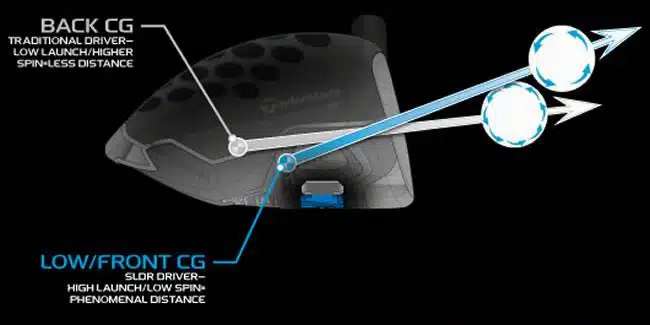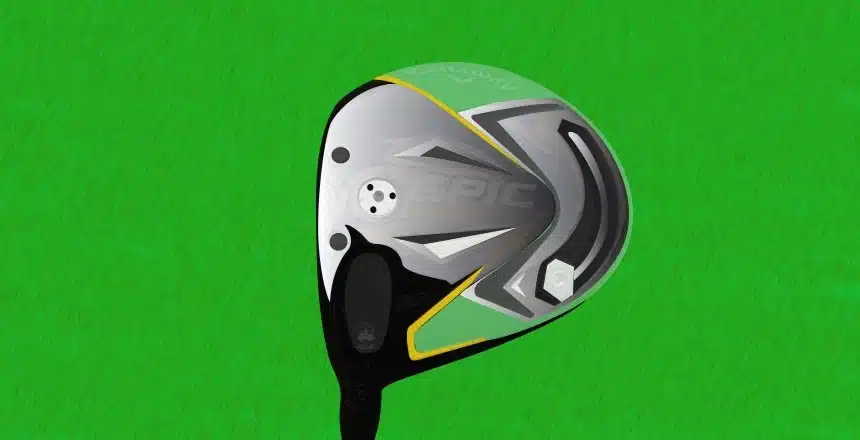Is there an ideal position of the center of gravity in golf clubs? First of all, what does CG mean in golf, to begin with?
You can manipulate this CG from right to left based on how much you slice your shots. Then, of course, there’s the low and high placement of the center of gravity to favor either a higher launch with less spin or a lower launch with more spin.
So such ball characteristics can be adjusted based on your skills and tendencies in golf. However, you can only manipulate trajectory and spin this way if you actually know the meaning and importance of CG.
In This Post
CG Meaning – Center of Gravity In Golf Explained

CG or center of gravity is a very common acronym that is used by golf brands. For example, the low CG of irons more geared towards beginners. The center of gravity is low, deep (meaning pushed farther back), etc. So what does all this really mean?
The positioning of the CG in irons, woods, wedges, and even putters is that point on the clubhead where its weight is perfectly and optimally balanced.
Now, this center of gravity location can be in the sole, face, or just about anywhere (a clubhead can be balanced in multiple ways). Just know that this center of gravity is the junction where all balance points meet.
And knowing the exact location, no doubt, is crucial indeed because even the smallest change or adjustment in the CG has the ability to affect performance drastically.
Every clubhead features a vertical (how high up from the sole) and a horizontal (how far from the shaft) CG placement. And also how far behind the clubface the center of gravity is positioned also matters.
How Golf Club CG Affects Shots and Performance?
Low CG, meaning towards the clubhead bottom, results in a higher launch with less spin.
High CG, towards the clubhead top, gives you a lower launch with more spin.
CG back placement, meaning away from the face, increases both the launch settings and spin conditions. And this is what makes the golf club more forgiving.
On the other hand, forward CG location, more toward the face, decreases launch and spin. Hence, the club becomes less forgiving to hit.
These are the basic rules of how the center of gravity in golf clubs affects key factors like trajectory and spin. So to sum it up, the further back and lower the CG, the easier it is for you to get your shots to launch higher.
This means vertical CG positioning has an impact on the trajectory. While horizontal CG affects accuracy. For instance, when the center of gravity is closer to the shaft, your chances of pushing or fading the ball are less likely. On the other hand, CG farther away from the shaft increases push/fade tendencies.
Center of Gravity In Golf Clubs Also Affects Feel!
The courtesy of CG extends to not just trajectory and spin but also feel.
When the CG placement is forward, the golf club feels heavier and the shaft stiffer. This explains why rear CG placement is such a common occurrence with easier-to-swing drivers for women. Because these are so much easier to square at impact, they’re not so challenging to control when executing a flawless swing sequence.
Moving On, How Much Does CG Actually Move?
CG adjustments (in the form of sliding weights in golf clubs) are often talked about as if they can move mountains, meaning totally transform ball speed. So how far do these adjustments go, to begin with?
The center of gravity location can and does only change within 15mm. In the case of most golf drivers, you can move the weight back and forth by just 3mm.
3 millimeters only?! That’s not a lot, right? It may not be such a drastic change yet it has a significant impact on performance.
CG Position/Adjustment In Woods
There are Callaway drivers, TaylorMade drivers, and more equipped with adjustable weights. And the fact that the CG is ‘alterable’ this way means you can optimize trajectory and spin based on how you swing, perform, etc. It even affects golf club MOI.
When the center of gravity is moved away, you get an increase in the dynamic loft with greater spin. Plus, the MOI or stability of that clubhead also receives a boost since the weight is pushed more toward the perimeter.
So if you’re a golfer who needs more forgiveness and height, you should be opting for low, back CG.
And now the other side of the coin features shifting that CG toward the face. The outcome of this is a lower launch and spin to make the driver less forgiving indeed but more playable.
Thus, forward CG is perfect for low handicappers and better players. It’s mostly low and forward. Low CG is the common denominator here since it’s proven to be effective for nearly all types of golfers.
Now about the accuracy-dictating vertical positioning of the CG in drivers. When weight is shifted away from or toward the hosel, you can actually optimize flight bias (fade or draw) to achieve a straighter ball flight.
CG Position/Adjustment In Irons
Time to talk about the differences between cavity-back irons and blade irons. The former are perimeter-weighted, which means the CG is pushed away from the face/hosel and more toward the perimeter. So that generates a higher launch and more spin for a more forgiving, straighter ball flight (game improvement irons indeed).
In some TaylorMade irons, this weight has been reduced even more and placed farther away from that clubface to bring about greater ‘mis-hit’ forgiveness.
However, more skilled players prefer irons where the center of gravity is located closer to the face/sole since this particular CG position adds more playability. Just because the CG, in this case, is also the center point of the clubhead’s rotational axis, shaping the shots and controlling spin and trajectory become much easier. Hence, better workability!
CG Position/Adjustment In Wedges & Putters
The location of the center of gravity also matters in the case of wedges and putters.
A good example of that would be manufacturers of wedges now engineering progressive CG locations. The CG placement, because of the increase in wedge loft, is only getting higher.
And that’s mainly due to the fact that wedges that are higher-lofted (between 56 degrees and 60 degrees) are more suited for producing higher spin and lower launch (improved control). While lower-lofted wedges (between 46 degrees and 54 degrees) give you a higher launch, which is better for full shots.
The Takeaway!
In summary, the role of CG in golf clubs is no light matter. More advanced technologies are coming up in order to further improve the location of the center of gravity. For example, now there are clubs with even lower CG placement to increase launch and minimize spin further just to boost distance more drastically.
So you should know all of these details about CG in your every club if you want to improve the way your golf clubs affect the launch, ball flight, spin, and even feel and distance.


Hi Jim – You inspire me with your game and your common sense qualities!